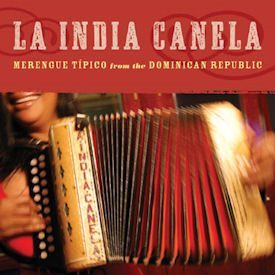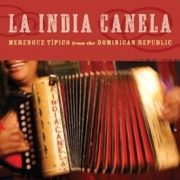LA INDIA CANELA – LA INDIA CANELA: MERENGUE TIPICO FROM THE DOMINICAN REPUBLIC
ARTIST: LA INDIA CANELA
TITLE: LA INDIA CANELA: MERENGUE TIPICO
FROM THE DOMINICAN REPUBLIC
LABEL: SMITHSONIAN/FOLKWAYS
MERENGUE TIPICO SLAMS RECESSION BLUES

Tuesday is the cruelest day. On Mondays, everyone at work is strung out, wondering how the weekend went by so fast. By Tuesday, we’re supposed to be in the groove again. I’m not. Driving my 30-mile commute to work, I curse the impending layoffs announced on our e-mail network (who’s next???). I surf the radio stations for relief but instead hear station after NPR station dissecting the disaster known as our economy. I ride the dial in search of a musical antidote to the recession blues — from classical to jazz to norteño to reggae. Sometimes I’m lucky.
Last Tuesday I wasn’t. The talk was more dismal than usual and the music ranged from bland to sheer noise. Then I remembered the CD I still had to review for FolkWorks. Something called La India Canela. I fed it in to the morose mouth of my Corolla’s CDplayer and…. Brrrrrrrrrrrrrr! Wow! Go! Yeee! Ha! The cascading keys of an accordion nearly swept my Corolla and me off La Brea Avenue. My shoulders started rolling and my hips swaying to the fast-paced, driving rhythms of tamboro and guira. Suddenly I was smiling ear to ear and the mouth of my CD player seemed to be smiling with me. Merengue tipico had rescued me from my recession(and Tuesday) blues.
Let us find out how La India Canela cast its spell – or rather her spell. In fact, the title of this 2008 Smithsonian/Folkways release refers to the virtuoso accordionist Lidia Maria Hernandez Lopez, a prominent interpreter of the Dominican Republic’s national dance. Brought up in El Limón, in the rural tobacco-growing region of Santiago Province, Lopez took up the accordion as a childhood diversion. Her parents noticed her natural talent early on and arranged for her to have lessons. By age 14, she played classic merengue tipico numbers with such vibrancy that Juan de Dios, a saxophonist famous in the Dominican Republic, who happened to hear her on a visit to El Limón, convinced her parents to let the teenager come to the capital to immerse herself in the world of merengue tipico. Before long, a group was formed to showcase her talents and Lidia had adopted the stage name, La India Canela. India refers to her mulatto racial heritage and is the preferred term for mixed race in the Dominican Republic. Canela (cinnamon), while also evoking her skin color, suggests the spicy allure of her playing style. While female accordionists have become accepted in her country since the 1960s, La India’s fame abroad is inspiring female musicians in other Latin American countries to surmount barriers to performance careers.
Naturally I have particular affection for the first cut on the CD, Aprietame Asi (Squeeze Me Like That). The addition of punchy saxophones to the ensemble perfectly complements La India’s fluid sound. The number also represents a musical milestone: Its mambo-based style helped bring tipico back into popularity in the mid-1990s while showcasing La India’s virtuosity. Until that resurgence of merengue tipico some 15 years ago, it was the tipico’s descendent, big band merengue, that dominated the dance floor. In fact, big band merengue is still the most prevalent form we hear abroad. Developed in the first half of the 20th century, it depends on written orchestral arrangements and spotlights wind instruments. Merengue tipico, on the other hand, centers on the diatonic button accordion supported by drums and percussion. And unlike its more polished counterpart, merengue tipico always includes improvisation.
The pieces on this CD range from some of the most popular traditional merengues to pieces composed by La India herself. It is hard to say which of the numbers is most rousing, but El Rancho, composed by La India with lyrics by journalist Huchi Lora, projects sheer joy and pride of country. It combines merengue tipico with palos drumming. The three long drums play interlocking patterns in a style of Afro-Dominican music found throughout the country.
Merengue tipico is considered the Dominican Republic’s national dance because it blends the country’s three cultural influences. The accordion comes directly from Europe. The two-headed tambora drum, played with the palm of the left hand and a stick in the right hand, came over from Africa with the slaves imported to work on the plantations. The metal guira scraper is considered to be of indigenous (Taino) origin.
No one is sure who composed El Papujito (The Bearded Rooster), Cut 5, an old merengue dealing with the still popular Dominican tradition of cockfights. The vocal soloist, Juan Cruz, is backed with by the other males in the band singing the refrain in multi-part harmony while La India’s accordion evokes the playfulness of the macho pastime.
In Cut 2, La India gives an appreciative nod to legendaryaccordionist Matoncito, playing his best-known work, a two-part merengue called Consagracion de Cariño. Two male vocalists, harmonizing a third apart, sing romantic lyrics:
You are so pretty, you are so beautiful that you enchant me.
I love only you, now and forever,
I devote my affection and my existence to you,
And I mean to love only you for eternity.
La India’s accordion improvises thrilling variations on the melody.
Merengue tipico ensembles have embraced additions and innovations since the musical form developed in the countryside during the 19th century. For example, La India’s group includes two saxophonists plus a conga player. But in the bars, discos, village celebrations, and, yes, cockfight rings where you hear merengue tipico today, there remains that driving energy of the four-beat rhythmic cycle and the sound of cascading accordion keys.
I heartily recommend La India Canela. But let theblues-ridden buyer beware: Merengue tipico will not permit you to wallow. And be careful listening to it while driving.
Audrey Coleman is a writer, educator, and passionate explorer of world music and culture.













